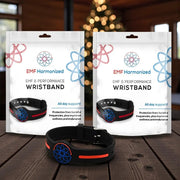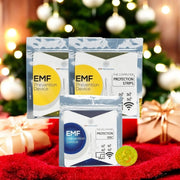We humans go to great lengths to ease and eradicate bodily pain feelings, using anything from ibuprofen to prescription drugs. However, many of the procedures we utilize just cover or numb the Pain momentarily, rather than addressing the underlying source of the discomfort.
Red light therapy for Pain is a different—and often preferable—method of addressing the root of Pain while also enhancing the body's natural healing processes. Thanks to technical advancements in at-home equipment, this non-invasive procedure has grown in popularity. Many varieties of light treatments are advertised as pain relievers, but red and near-infrared light are the most well-studied types of LED light therapy. Here's a rundown of how pain treatment with light therapy works and how to utilize at-home light therapy equipment.
Note: Visit the QuantusLife.com shop to learn more about the most powerful red light therapy panels available for pain treatment and other purposes.
When and How Is Red Light Therapy Used?
Red light treatment exposes the skin to concentrated wavelengths of red or near-infrared (NIR) light using light-emitting diode (LED) devices. Although the human eye cannot dependably detect the whole infrared spectrum, they are considered part of the visible spectrum of Light. As light particles (known as photons) penetrate past the epidermis and into deeper tissues, red and NIR light wavelengths benefit the human body.
Photons activate energy-producing organelles known as mitochondria when they penetrate individual cells, causing mitochondria to create additional energy in adenosine triphosphate (ATP). Scientists think that cells fueled by ATP are more capable of self-repair and replication. As a result, the skin, bone, muscle, and connective tissue recover more quickly.
Unlike ultraviolet (UV) light, red light does not cause the skin to burn. Although you may feel heated, red light treatment is safe and has no negative effects when used as instructed.

How Does Red Light Therapy Help With Pain?
Red light treatment, also known as photobiomodulation or low-level light therapy (LLLT), does not mask our feeling of Pain, unlike over-the-counter or prescription medications. Rather, it acts at the cellular level to promote proper cell function, which leads to a healthier, pain-free body.
Red light therapy has demonstrated considerable therapeutic promise in clinical studies for treating several illnesses as a natural and effective treatment. Osteoarthritis and other joint pain, bone breakage, muscular injuries, connective tissue problems, nervous system illnesses, and spinal disorders are only a few examples.
But how does red light treatment function in practice? Here are some of the ways it reduces Pain and heals the body on a cellular level.
Inflammation is reduced by red Light.
Inflammation is a frequent cause of discomfort. Chronic inflammation may obstruct the body's recovery capacity, even if acute inflammation is an immune system reaction and part of the normal healing process. Red Light encourages cellular repair and regeneration and reduces the body's inflammatory response.
Red Light boosts Cellular Energy Production.
Red Light stimulates mitochondria, resulting in a burst of energy production. Energized cells can execute specialized activities at their best and duplicate and repair damaged or inflamed parts of the body, resulting in a faster recovery.
Red Light boosts blood Flow.
Red Light increases blood flow to a treatment region by encouraging the creation of microscopic blood vessels known as capillaries. This results in an influx of nutrients and oxygen to cells and the clearance of waste that might obstruct the healing process.
Collagen production is boosted by red Light.
Collagen, an essential structural protein found in skin, muscle, and connective tissue, has been stimulated by red light treatment. While this collagen-building action makes red Light therapy a popular anti-aging treatment, it also explains its success in treating painful cutaneous (skin) and subcutaneous (just under the skin) wounds and injuries.
Near-Infrared Light Therapy vs. Red Light Therapy
NIR light therapy is often used in conjunction with red light therapy. The visible light spectrum includes both red and near-infrared wavelengths; near-infrared Light is somewhat outside of it, rendering it undetectable to the human eye but detectable with specific sensors.
Red Light has a wavelength of 630 nanometers (nm) to 700nm, whereas NIR light has a wavelength of 700nm to 1100nm. Red Light with somewhat shorter wavelengths may permeate the skin to a depth of around 10 millimeters, whereas NIR light with longer wavelengths can penetrate the skin to 2 to 7 centimeters.
The difference in penetration depths distinguishes the therapeutic capacities of red and NIR wavelengths. Red light treatment, for example, may activate cellular activity in the epidermis and subcutaneous tissues, while NIR light therapy can excite cells deeper inside the body, resulting in pain alleviation.
There are wavelengths in the red and near-infrared light spectrums suited for various therapies. In this article, you may learn more about those wavelengths.
Red and near-infrared light therapy are used to treat many types of Pain.
Red light therapy and near-infrared light therapy, whether used independently or combined, are very adaptable therapies that give focused relief for severe illnesses. Some instances are as follows:
Pain in the Joints
Joint Pain is a catch-all word describing a variety of joint pains, including overuse injuries (i.e., injuries induced by repeated motions) and osteoarthritis (discussed in the following section). The cartilage that cushions joints breaks away as a result of overuse trauma. This may be painfully painful, resulting in the overuse of the muscles around those joints. This, in turn, might result in greater damage and discomfort.
Red light treatment (as well as near-infrared light therapy) may be beneficial in various ways. It decreases inflammation around inflamed joints, improves blood circulation to the wounded region, and boosts collagen formation, an important cartilage component.
According to a 2011 research published in the Journal for Laser Surgery, Phototherapy, and Photobioactivation, Red/NIR light therapy may alleviate joint discomfort whether used alone or in combination. Participants in this trial, all of whom had sacroiliac joint discomfort, had 10 830nm near-infrared light treatment sessions over five weeks. All had considerable improvements in discomfort, and two-thirds had enhanced trunk mobility.
Osteoarthritis
Osteoarthritis is a degenerative condition caused by joint wear and strain. It affects over 32.5 million people in the United States, ranging from professional athletes to the elderly. Inflammation, which is at the base of this condition, is addressed by red and near-infrared light treatment. In reality, studies suggest that continuous therapy may aid people with osteoarthritis pain and can even improve mobility when paired with exercise. Learn more about utilizing low-level laser therapy (LLLT) to treat the arthritic pain.
Carpal Tunnel Syndrome (CTS) is a condition that affects.
Carpal tunnel syndrome is characterized by pain, tingling, and numbness in the hands caused by pressure on the median nerve in the wrist. The capacity of red light therapy to target inflamed parts of the body and enhance blood circulation has been demonstrated in studies to alleviate short-term pain for patients suffering from carpal tunnel syndrome.
Arthritis that affects the joints is called Rheumatoid Arthritis (RA).
Rheumatoid arthritis is an autoimmune disease that targets joints, causing moderate to severe joint pain, inflammation, stiffness, and limited mobility. Because of its anti-inflammatory properties, red light therapy has shown to be a viable treatment for this illness.
LLLT decreased rheumatoid arthritis pain in patients by 70% in a controlled trial conducted by researchers at the University of Ottawa in Ontario, Canada, in 2005. Morning stiffness was reduced significantly, and palm flexibility improved significantly.
Bursitis
Bursitis is a painful ailment caused by inflammation of the bursae, which are tiny fluid-filled sacs between the tendon and bone that lubricate the outer hip joint. It is often connected with jogging and other high-impact sports activity. Red light treatment speeds up the healing process by reducing swelling in the treated regions.
Chronic Pain is defined as discomfort that lasts longer than six months and causes the surrounding muscles to tense, limit movement and depletes energy. Frequent headaches, low backaches, arthritis, fibromyalgia, and nerve damage are all examples of chronic pain.
Chronic pain sufferers may benefit from red light treatment to reduce inflammation while improving blood cell synthesis and cellular energy generation. This is crucial for people suffering from chronic pain, which may occur. Furthermore, since red and near-infrared light therapy may be used safely at home (or on the move with smaller devices), they give relief as required.
Back and Neck Ache
Neck and back pain may vary from unpleasant to debilitating, depending on whether it's the consequence of a few nights of poor sleep or the aftereffects of a sports injury or accident. Because inflammation is often the reason, red light therapy is an excellently targeted treatment for neck and back pain, particularly lower back pain, which is quite prevalent.
Studies have shown the red light treatment enhances the range of motion while also reducing discomfort. Near-infrared and infrared treatments were proven to improve chronic low back pain in a 2006 research published in Pain Research and Management.
At-home red light treatment
How to Use Red Light Therapy to Treat and Manage Pain
One of the nicest things about light therapy for Pain is that it is safe and simple to use at home.
A typical red light treatment session is a passive one in which you sit, stand, or lay down in front of the device and allow the photons to permeate your skin for a certain amount of time, such as 15 to 30 minutes. You may also have an "active recovery" session in front of the device, which includes moving or stretching; however, persons with chronic or severe Pain may choose to rest and remain motionless.
Pain-Relieving Red Light Devices
The light treatment gadget you use should be appropriate for the discomfort you're attempting to alleviate. The ideal therapeutic red wavelengths of 630nm and 660nm, for example, are most effective for healing surface injuries. NIR light wavelengths of 810nm, 830nm, and 850nm penetrate deeper into inside tissues. So, find out where your pain is coming from, and then think about which form of light treatment would work best for you.
When buying a red light gadget for your house, choose one with high power so that the Light is intense enough to penetrate the body's tissues. Irradiance refers to the quantity of energy or photons that permeate a certain body region, while some devices have a lower irradiance. As a result, a device's ability to provide the healing energy of red and near-infrared light is reduced—the greater the irradiance of a red light device, the better the therapy coverage and intensity.
Theralumen Band LED device emits exceptionally high-output red and near-infrared Light in a patented mix for optimal therapeutic efficacy. For one to four months, many 15- to 20-minute sessions each week may help relieve discomfort and restore your quality of life.
Before self-treating with any red Light therapy equipment, you should see a medical expert ensure that you aren't misdiagnosing an illness.
What Is the Time It Takes for Red Light Therapy to Work?
As amazing and useful as it is, red Light is not a quick remedy for Pain. Remember that it operates on a cellular level, and cellular transformation takes time. As the body "resets" itself in reaction to the bioactive characteristics of red and near-infrared light, you will notice a decrease in chronic Pain with frequent sessions.
The key to getting this outcome is consistency. It may take many months of constant irradiation with a red light device to reduce or eliminate discomfort in many chronic diseases.
However, regularly using a red light treatment may lessen the chances of a chronic illness reoccurring. When treating illnesses like arthritis or persistent knee pain, mixing red and near-infrared Light will likely provide quicker and more effective effects.
Rachel Callahan is a case study.
Rachel Callahan, a blogger, reported her experience with red light treatment a few years ago. Calahan, an active runner, suffered from chronic and ongoing back discomfort due to reoccurring muscular knots, which had a substantial detrimental influence on her fitness, sleep, and general comfort. To get through the day, she visited a physical therapist regularly and followed a regimen of ibuprofen and heating pad breaks.
One of the most impressive features of Callahan's journey was her ability to reduce her running speed from a 10:30-minute mile to a sub-10-minute mile; she sometimes ran a completely flat nine-minute mile.
Callahan described the sensation in her legs during runs as "bionic," implying that red light treatment not only treated her chronic Pain but also had a full-body impact that enhanced her fitness and performance significantly.
An athlete is using red light treatment.
Using Red Light Therapy to Get Past Pain
Pain, whether chronic or acute and regardless of its cause, may make your life difficult. Pain relief using nonsteroidal anti-inflammatory drugs (NSAIDs) or powerful over-the-counter pain relievers is prevalent, but these treatments don't work for treating Pain at its cause.
TheraLumen Therapy Lights are the most powerful at-home devices on the market, with the greatest variety of therapeutic wavelengths. LED lights can deliver pain treatment at the deepest levels, whether it's via a tiny portable gadget or a customized array of panels. Consider red light therapy treatments in the comfort of your own home for a complete, non-invasive, and natural pain treatment.







